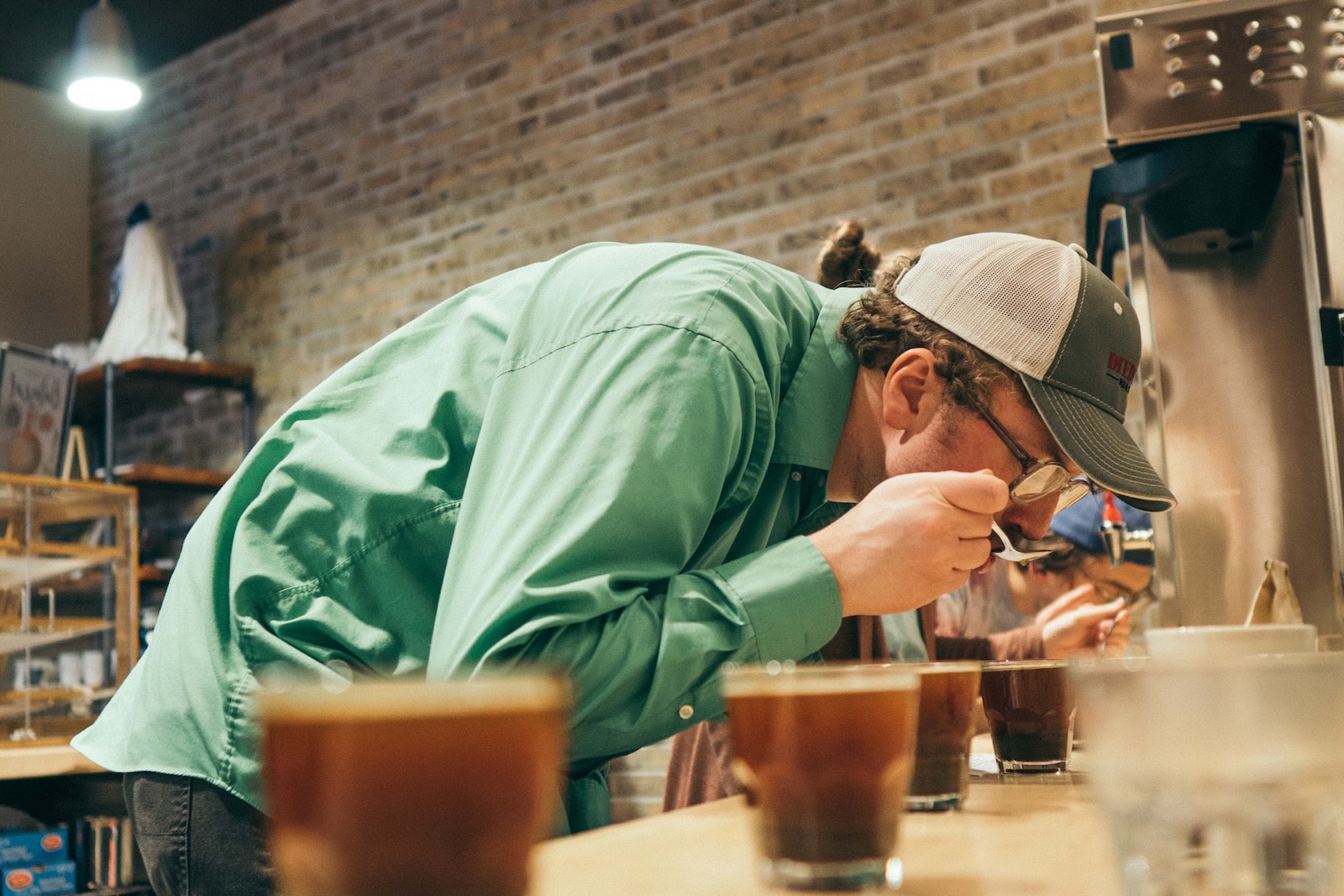Are you tired of drinking the same old cup of coffee each morning, devoid of any excitement or flavor? Do you yearn to unlock the hidden nuances and complexities that lie within each sip? Look no further, because we’re about to embark on a journey into the captivating world of coffee tasting.
In this blog post, we will delve into the artistry behind developing your palate and discover how to truly appreciate every subtle note, aroma, and texture that makes each cup a unique work of delicious art. So grab your favorite mug, take a seat in your cozy corner, and let’s awaken our taste buds to the wonders awaiting us in every glorious brew!
Introduction to Coffee Tasting

Coffee is much more than just a morning pick-me-up or a necessary caffeine boost. It’s an art form that has been perfected over centuries, with dedicated coffee connoisseurs constantly seeking out the perfect brew. One of the essential elements of truly appreciating and understanding this beloved beverage is through the practice of coffee tasting.
Coffee tasting, also known as cupping, is the process of evaluating and analyzing different types of coffee based on its flavor, aroma, body, and other characteristics. Similar to wine tasting, it involves using all your senses to fully experience and appreciate the complexity of different coffees.
The origins of coffee tasting can be traced back to the early Arab cultures who first discovered the magical properties of coffee beans in Ethiopia around 900 AD. Since then, it has become an integral part of coffee culture around the world. From small specialty cafes to large-scale roasteries, professionals and enthusiasts alike participate in this sensory experience to discover new flavors and refine their palates.
Why should you learn how to taste coffee?
Beyond simply enjoying a good cup of joe, learning how to taste coffee can help you develop a deeper appreciation for this drink’s intricate flavors and aromas. It allows you to identify subtle differences between various types and origins of coffee beans. By honing your palate through practice and exposure to different coffees, you will gain a more refined ability to distinguish between premium quality coffees versus those with subpar taste.
The Importance of Developing Your Palate
Developing your palate is a crucial skill for anyone who wants to truly appreciate and understand the complexities of coffee. Your palate is essentially your sense of taste, which can be trained and developed over time through regular practice and exposure to different flavors and textures.
One of the main reasons why developing your palate is important in the context of coffee tasting is because it allows you to fully experience all that a cup of coffee has to offer. While most people may think that coffee only has one or two basic flavors, such as bitter or sweet, the truth is that there are countless flavors and subtleties that can be found in different types of coffee beans, roasts, and brewing methods.
By honing your sense of taste through deliberate practice, you will become more sensitive to these nuances and be able to identify them more easily. This will not only enhance your overall enjoyment of coffee but also give you a deeper appreciation for the craft behind it.
Another benefit of developing your palate is that it enables you to better communicate about what you are tasting. Whether you are trying new blends with friends or working in the industry as a barista or roaster, being able to articulate specific flavor profiles can help you share knowledge and engage in meaningful discussions about coffee.
Factors that Affect the Taste of Coffee
Coffee is a complex and diverse beverage that offers a wide range of flavors and aromas. From dark, bold roasts to light, floral blends, there is something for every coffee lover’s taste buds. But have you ever wondered what factors contribute to the unique taste of your favorite cup of coffee? In this section, we will explore the various factors that affect the taste of coffee and how they can impact your experience as a coffee taster.
1] Bean Varieties:The type of beans used to make coffee plays a significant role in its taste. Arabica beans are known for their delicate, fruity flavor profile with hints of sweetness, while Robusta beans offer a more bitter and earthy taste. Different regions also produce distinct bean varieties, such as Ethiopian Yirgacheffe with its floral notes or Sumatran Mandheling with its herbal tones.
2] Roasting Level:Roasting is the process that transforms green coffee beans into the aromatic brown ones we all know and love. Depending on the level of roast – from light to dark – the flavor profile changes drastically. Lighter roasts tend to have a lighter body and brighter acidity with subtle fruit notes, while darker roasts offer a bolder body and deeper flavors like chocolate or caramel.
3] Brewing Method:The brewing method used can greatly influence the taste of your coffee due to differences in extraction time and temperature. For example, pour-over methods such as Chemex or V60 result in a cleaner and more delicate cup, while immersion methods like French press or cold brew produce a fuller and more robust cup of coffee.
4] Water Quality:
Water makes up 98% of your coffee, so it’s no surprise that the quality of water used can significantly impact its taste. Hard water with high mineral content can result in a bitter and unpleasant brew, while soft water may lead to a flat and under-extracted cup. Ideally, the water should have a balanced pH level and low mineral content for the best tasting coffee.
5] Brewing Ratio:The brewing ratio refers to the measurement of coffee grounds to water used in the brewing process. A higher ratio means more coffee grounds are used per unit of water, resulting in a stronger and more concentrated brew. The opposite is true for a lower ratio, which yields a milder and less intense cup of coffee.
6] Age of Beans:
Freshly roasted beans will offer the best taste as they have not had time to stale or lose their flavor compounds. It is recommended to use beans within two weeks of roasting for optimal taste. As beans age, they start to lose their oils and aroma, resulting in a less flavorful cup.
Different Roasts and their Flavors
Coffee roasting is a crucial step in the production of coffee, as it not only determines the appearance and aroma of the beans but also greatly affects their flavor. The level of roasting can dramatically alter the taste profile of coffee, from light and delicate to dark and bold. In this section, we will discuss the different types of roasts and how they influence the flavors in your cup.
1] Light Roast
Light roast coffees are lightly browned with no visible oils on the surface. This type of roast preserves much of the bean’s natural character and acidity, making it great for showcasing certain origins or varietals. These coffees tend to have a crisp, bright flavor profile with hints of fruitiness and floral notes. They are often described as having a “clean” taste.
2] Medium Roast
Medium roasts are slightly darker than light roasts, with some oils beginning to appear on the surface. The higher heat during this stage results in less acidity but still maintains some of the bean’s original characteristics. The overall flavor is more balanced, with a smooth body, subtle sweetness, and nutty undertones.
3] Medium-Dark Roast
As we move towards medium-dark roasts, we start to enter into what many consider classic coffee tastes – bittersweet chocolate notes along with caramelization from increased sugar development during prolonged exposure to heat. These beans become shiny due to oil migrating towards their surface giving them an irresistibly rich aroma; think roasted nuts with a slight hint of smokiness.
4] Dark Roast
Dark roast coffees have been roasted beyond the first “crack” – an audible popping sound that occurs when moisture in the beans is released. This extra time intensifies the flavor, aroma and results in a darker bean color and almost no acidity left – a characteristic sought after by some drinkers who prefer bolder tasting cups. These are often described as having bold, bitter flavors with notes of dark chocolate or roasted nuts.
5] Espresso Roast
Espresso roasts are typically very dark roasts that are specifically designed for use in espresso machines. The high heat used to roast these beans extracts intense flavors and oils, resulting in a rich, full-bodied cup with a thick crema on top. The taste can vary depending on the origin of the beans, but they often have bold, sweet flavors with notes of caramel and dark chocolate.
How to Continuously Develop Your Palate
Developing your palate is an essential skill if you want to truly appreciate the complexity and nuances of coffee flavors. As with any art form, it takes time, practice, and patience to continuously develop your palate. In this section, we will discuss some tips and techniques on how you can hone your taste buds and continue to evolve your coffee tasting skills.
1] Start with the basics: Before jumping into advanced tasting techniques, it’s important to have a solid foundation of basic flavor profiles found in coffee. These include sweetness, acidity, bitterness, body, and aftertaste. Take some time to familiarize yourself with these elements by trying different types of coffee from various regions and roasts.
2] Practice mindful tasting: Mindful tasting means paying full attention to the flavors in your cup without any distractions. Sit down in a quiet place and focus on each sip by observing its appearance, aroma, and taste. Try to identify specific flavors or notes that stand out to you.
3] Keep a tasting journal: Keeping a record of your tastings is helpful for tracking your progress and identifying patterns in your preferences. Write down the origin of the coffee, roast level, brewing method, as well as your detailed observations on appearance, aroma, flavor profiles, and overall impression.
4] Compare side by side: To further develop your palate’s ability to differentiate flavors, try doing blind taste tests or making direct comparisons between different types of coffee (e.g., single-origin vs blend or light roast vs dark roast). This exercise can help you identify specific characteristics in each cup and develop a more discerning palate.
5] Pay attention to your environment: The environment can greatly influence your perception of taste. Make sure to eliminate any strong scents or flavors before tasting coffee, such as perfume, cologne, or spicy food.
6] Experiment with different brewing methods: Each brewing method brings out different flavors and nuances in the coffee. Try experimenting with different methods like pour-over, French press, or espresso to see how it affects the taste of your coffee.
7] Attend cuppings and tastings: Cupping events or tastings are an excellent opportunity to try a variety of coffees from different origins and roasts in a controlled setting. These events are also great for getting expert guidance on how to taste and evaluate coffee.
8] Get feedback from others: Asking for feedback from other coffee enthusiasts or professionals is another valuable way to continuously develop your palate. They may pick up on flavors or notes that you may have missed and give suggestions on how to improve your tasting skills.
Conclusion
As you can see, there is much more to coffee tasting than simply enjoying a warm beverage. It requires developing your palate and paying attention to the finer details of each cup. By following these tips and practicing regularly, you will be able to unlock a whole new world of flavors and appreciate the art of coffee on a deeper level. So next time you take a sip of your favorite brew, remember to savor every flavor and aroma that it has to offer. Happy coffee tasting!







